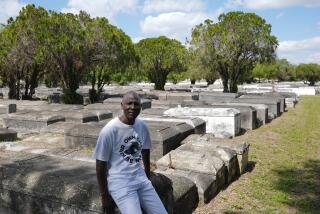Dig in Brooklyn may settle mystery of lost grave of famed Maryland 400 soldiers from Revolutionary War
Reporting from BALTIMORE â More than two centuries after one of the bloodiest battles of the American Revolution, archaeologists are digging up a concrete lot in Brooklyn, N.Y., to settle a mystery over the mass grave of famed Maryland soldiers.
Known as the Maryland 400, the soldiersâ stand on the battlefield in 1776 earned Maryland the distinction of the âOld Line State.â The young men from Baltimore, Annapolis and beyond died while stopping the British from quashing Americaâs rebellion just as it began.
New York City bought the vacant lot at 9th Street and 3rd Avenue long presumed to conceal the Marylandersâ bones. The city plans to build a pre-kindergarten school on the grounds. Preservationists requested an archaeological investigation before construction begins.
âThey played a major role in saving the American Revolution,â said Bob Furman, an author and president of the Brooklyn Preservation Council. âThey deserve better than what they have gotten.â
What they have gotten, Furman says, is an undignified resting place. He spent years gathering records â deeds, maps, newspaper articles and letters â that suggest the Marylandersâ remains may lie beneath the lot beside an American Legion post.
New York State officials acknowledged the site when they hung the placard next door to it in 1952: âHere lie buried 256 Maryland soldiers who fell in the Battle of Brooklyn.â Half a century later, they installed a second sign that designates the lot a âpresumedâ burial ground.
The parking lot-as-graveyard theory gained celebrity support recently from English actor Patrick Stewart. The Brooklyn resident of âStar Trekâ fame told GQ magazine that âall it is is a concreted-over car park, but underneath the concrete is the mass grave. Itâs worth making, I think, a bit of a fuss of.â
Historians have questioned whether a mass grave of the Marylanders actually exists. The theory remained largely untested until now.
New Yorkâs State Historic Preservation Office requested the archaeological survey, and crews began digging last month. âItâs underway and obviously gathered a lot of attention,â said Fred Maley, spokesman for the New York City School Construction Authority. An archaeological report is due after the dig.
âThere are some people who are very certain that there is a mass grave to find. I donât know that there is ⌠simply because they would have been killed in different locations,â said Owen Lourie, a historian with the Maryland State Archives. He runs the archivesâ Maryland 400 research project to chronicle the lives of the celebrated soldiers.
Four hundred may not represent their actual numbers, Lourie said. Researchers think about 250 of the Marylanders were killed or captured. Soon after their heroic stand, the regimentâs legend spread.
Brooklyn was a swamp in 1776, and the Marylanders actually fell in battle about six blocks northeast of the vacant lot, said Kimberly Maier, executive director of the Old Stone House & Washington Park historic site dedicated to revolutionary Brooklyn.
âI hate to disappoint you; there is no mass grave,â she said. âThe British and Dutch would have traditionally buried traitors where they fell.â
But itâs precisely the swampiness of the battlefield that causes some to speculate about the vacant lot. It was once a wooded island in the swamp and could have been the only dry ground suitable for burial. Some researchers think the British dug 100-foot trenches to inter the Marylanders. In the 19th century, farmers wrote of finding bones while plowing.
In the summer of 1776, British warships sailed for New York in the largest fleet since the Spanish Armada. Some 22,000 troops marched from the shores of Brooklyn.
Gen. George Washington amassed his Continental Army to defend the strategic New York harbor. Outnumbered 2-1, the Americans formed a semicircle with a regiment of about 950 Marylanders anchoring the right end. They were in their early 20s, these farmers, tradesmen and sons from wealthy Annapolis families.
âMen with absolutely no combat experience,â Lourie said.
The fighting erupted before sunrise Aug. 27, 1776. British forces overwhelmed the left end of the American line, and the formation collapsed into panic and confusion. American commanders ordered a retreat. Some escaped by wading through the Gowanus swamp as the British poured in.
âMy captain was killed, first lieutenant was killed, second lieutenant shot through the hand, two sergeants was killed, one in front of me,â Cpl. William McMillan of Maryland wrote in a letter discovered by historians.
The Marylanders drew together under their Baltimore-born commander, Maj. Mordecai Gist. Against suicidal odds, they charged again and again.
Their stand held the British at bay while Washingtonâs army escaped to fight again. The general reportedly watched from a hilltop and wrung his hands, telling an aide, âMy God, what brave men I must this day lose.â
Since that time, Marylandâs proud title of the âOld Line Stateâ has been stamped on coins and painted on road signs. A stone monument to the Marylanders was erected in Brooklyn â noting they âsaved the American armyâ â about a mile away from the lot being excavated.
Former Maryland Gov. Martin OâMalley visited the Brooklyn battlefield about four years ago and met with members of the American Legion beside the lot. Today, the members are closely watching the dig next door.
âEverybodyâs all hopped up and excited and hoping they find the remains,â said Peter DeAngelis, an 85-year-old Korean War veteran.
The veterans have quietly served as stewards over the presumed burial ground for decades. They wear patches with the Maryland flag, and a citation from current Maryland Gov. Larry Hogan hangs framed on the wall of their post. Each year, they assemble with their rifles to read the names of the Marylanders; someone rings a bell softly between each name.
Even if the dig reveals nothing, the aging veterans say, they will continue their small salute each year to the men of the Maryland 400, wherever they may rest.
Prudente writes for the Baltimore Sun.
More to Read
Sign up for Essential California
The most important California stories and recommendations in your inbox every morning.
You may occasionally receive promotional content from the Los Angeles Times.










